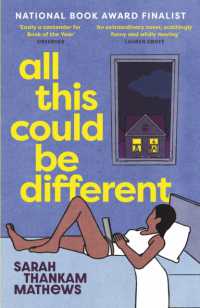Full Description
Who Look at Me?!: Shifting the Gaze of Education through Blackness, Queerness, and the Body explores how we, as a society, see Blackness and in particular Black youth. Drawing on a range of sources, the authors argue that the ability to operationalize the sentiment that #BlackLivesMatter, requires seeing Blackness wholly, as queer, and as a site of subversive knowledge production. Continuing the work of June Jordan and Langston Hughes, and based on their work as a Black queer artist collective known as Hill L. Waters, Who Look at Me?! provides alternative tools for reading about and engaging with the lived experiences of Black youth and educational research for and about Black youth. In this way, the book presents not only the possibilities of envisioning teaching and research practices but presents examples that embrace, celebrate, and make room for the fullness of Black and queer bodies and experiences. This work will appeal to those interested in emancipatory methodological and educational practices as well as interdisciplinary conversations related to sociocultural constructions of race and sexuality, politics of Blackness, and race in education.
Contents
Acknowledgements
Prologue
Why Auto/Ethnography Education and Performance Now: Who Look at me, Now: Reflections on Being Seen
Framing Shifting the Gaze
The Origins of Shifting the Gaze in Our Work
Shifting the Educational Gaze Now: Insisting on Pedagogies of Freedom, Creativity, and Praxis
Tools to Engender Gaze Shifting
Autoethnography and Education
A Note to Our Read(er)s
Organization of the Book
Reflection Questions & Interactive Exercise
Chapter 1: When You See Me: Notes on Terrible Educations
Reflections
Naming & Unlearning: Pedagogies of Resistance
I Am, We Are, Before That: Letters to the Future
Reflection Questions
Chapter 2: Reflections on Bodies on Display: Exploring the Radical Potential of the Black, Queer Body
Dimensions of Body
Bodies on Display: Pleasure
Learning through the Body: What Being on Display Taught Us
Deep Creation Happens with/in the Feminine: A Lesson
Reorienting the Gaze: Notes on Pleasure and Blended Scripting
Conclusion
Reflection Questions & Interactive Exercise
Chapter 3: Looking Again: Collective Visions, Collective Sight/Seeing
SOLHOT Lesson I: "Just because...Don't Mean..."
SOLHOT Lesson II: Save Yourself First: Recollecting Dirty Work and Wreckless Theatrics
Conclusion
Reflection Questions
Chapter 4: Answering the Call: Manifesting the Spirit of Auto/Ethnography
The Contribution of Auto/Ethnography to Qualitative Research
Manifesting & Autoethnography: Charting New Directions in the Field
Reflection Questions & Interactive Exercise
Chapter 5: When We Look at Each Other: An Auto/Ethnography of Togetherness
Searching for Collectivity in Auto/Ethnography
More than Collaboration, We Love Each Other: Coming to Collective Auto/Ethnography
Reflection Questions
Conclusion Shifting Sociocultural Gazes: Toward Seeing Blackness Anew
Black Scenes/Seen Black
Reflection Questions & Interactive Exercise
Epilogue
Dear Uncle Jimmy
References
About the Authors
Index







